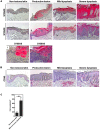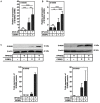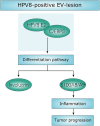Chronic Inflammatory Microenvironment in Epidermodysplasia Verruciformis Skin Lesions: Role of the Synergism Between HPV8 E2 and C/EBPβ to Induce Pro-Inflammatory S100A8/A9 Proteins
- PMID: 29563902
- PMCID: PMC5845987
- DOI: 10.3389/fmicb.2018.00392
Chronic Inflammatory Microenvironment in Epidermodysplasia Verruciformis Skin Lesions: Role of the Synergism Between HPV8 E2 and C/EBPβ to Induce Pro-Inflammatory S100A8/A9 Proteins
Abstract
Persistent genus β-HPV (human papillomavirus) infection is a major co-factor for non-melanoma skin cancer in patients suffering from the inherited skin disease epidermodysplasia verruciformis (EV). Malignant EV lesions are particularly associated with HPV type 5 or 8. There is clinical and molecular evidence that HPV8 actively suppresses epithelial immunosurveillance by interfering with the recruitment of Langerhans cells, which may favor viral persistence. Mechanisms how persistent HPV8 infection promotes the carcinogenic process are, however, less well understood. In various tumor types chronic inflammation has a central role in tumor progression. The calprotectin complex consisting of S100A8 and S100A9 proteins has recently been identified as key driver of chronic and tumor promoting inflammation in skin carcinogenesis. It induces chemotaxis of neutrophil granulocytes and modulates inflammatory as well as immune responses. In this study, we demonstrate that skin lesions of EV-patients are massively infiltrated by inflammatory cells, including CD15+ granulocytes. At the same time we observed a very strong expression of S100A8 and S100A9 proteins in lesional keratinocytes, which was mostly confined to the suprabasal layers of the epidermis. Both proteins were hardly detected in non-lesional skin. Further experiments revealed that the HPV8 oncoproteins E6 and E7 were not involved in S100A8/A9 up-regulation. They rather suppressed differentiation-induced S100A8/A9 expression. In contrast, the viral transcription factor E2 strongly enhanced PMA-mediated S100A8/A9 up-regulation in primary human keratinocytes. Similarly, a tremendous up-regulation of both S100 proteins was observed, when minute amounts of the PMA-inducible CCAAT/enhancer binding protein β (C/EBPβ), which is expressed at low levels in the suprabasal layers of the epidermis, were co-expressed together with HPV8 E2. This confirmed our previous observation that C/EBPβ interacts and functionally synergizes with the HPV8 E2 protein in differentiation-dependent gene expression. Potent synergistic up-regulation of S100A8/A9 was seen at transcriptional and protein levels. S100A8/A9 containing supernatants from keratinocytes co-expressing HPV8 E2 and C/EBPβ significantly induced chemotaxis of granulocytes in migration assays supporting the relevance of our finding. In conclusion, our data suggest that the HPV8 E2 protein actively contributes to the recruitment of myeloid cells into EV skin lesions, which may support chronic inflammation and progression to skin cancer.
Keywords: C/EBP; E2; HPV; S100A8/A9; epidermodysplasia verruciformis; inflammation.
Figures






Similar articles
-
The cutaneous beta human papillomavirus type 8 E6 protein induces CCL2 through the CEBPα/miR-203/p63 pathway to support an inflammatory microenvironment in epidermodysplasia verruciformis skin lesions.Front Cell Infect Microbiol. 2024 Mar 6;14:1336492. doi: 10.3389/fcimb.2024.1336492. eCollection 2024. Front Cell Infect Microbiol. 2024. PMID: 38510961 Free PMC article.
-
Identification of C/EBPα as a novel target of the HPV8 E6 protein regulating miR-203 in human keratinocytes.PLoS Pathog. 2017 Jun 22;13(6):e1006406. doi: 10.1371/journal.ppat.1006406. eCollection 2017 Jun. PLoS Pathog. 2017. PMID: 28640877 Free PMC article.
-
Human papillomavirus type 8 interferes with a novel C/EBPβ-mediated mechanism of keratinocyte CCL20 chemokine expression and Langerhans cell migration.PLoS Pathog. 2012;8(7):e1002833. doi: 10.1371/journal.ppat.1002833. Epub 2012 Jul 26. PLoS Pathog. 2012. PMID: 22911498 Free PMC article.
-
Calprotectin and the Initiation and Progression of Head and Neck Cancer.J Dent Res. 2018 Jun;97(6):674-682. doi: 10.1177/0022034518756330. Epub 2018 Feb 14. J Dent Res. 2018. PMID: 29443623 Free PMC article. Review.
-
S100A8 and S100A9 in inflammation and cancer.Biochem Pharmacol. 2006 Nov 30;72(11):1622-31. doi: 10.1016/j.bcp.2006.05.017. Epub 2006 Jul 17. Biochem Pharmacol. 2006. PMID: 16846592 Review.
Cited by
-
S100A8 and S100A9, both transcriptionally regulated by PU.1, promote epithelial-mesenchymal transformation (EMT) and invasive growth of dermal keratinocytes during scar formation post burn.Aging (Albany NY). 2021 Jun 7;13(11):15523-15537. doi: 10.18632/aging.203112. Epub 2021 Jun 7. Aging (Albany NY). 2021. PMID: 34099591 Free PMC article.
-
Fusobacterium nucleatum Facilitates M2 Macrophage Polarization and Colorectal Carcinoma Progression by Activating TLR4/NF-κB/S100A9 Cascade.Front Immunol. 2021 May 21;12:658681. doi: 10.3389/fimmu.2021.658681. eCollection 2021. Front Immunol. 2021. PMID: 34093546 Free PMC article.
-
IL-17A exacerbates psoriasis in a STAT3 overexpressing mouse model.PeerJ. 2023 Jul 14;11:e15727. doi: 10.7717/peerj.15727. eCollection 2023. PeerJ. 2023. PMID: 37465147 Free PMC article.
-
Cross-talk of cutaneous beta human papillomaviruses and the immune system: determinants of disease penetrance.Philos Trans R Soc Lond B Biol Sci. 2019 May 27;374(1773):20180287. doi: 10.1098/rstb.2018.0287. Philos Trans R Soc Lond B Biol Sci. 2019. PMID: 30955489 Free PMC article. Review.
-
HPV8 Reverses the Transcriptional Output in Lrig1 Positive Cells to Drive Skin Tumorigenesis.Cancers (Basel). 2022 Mar 25;14(7):1662. doi: 10.3390/cancers14071662. Cancers (Basel). 2022. PMID: 35406439 Free PMC article.
References
-
- Akgul B., Karle P., Adam M., Fuchs P. G., Pfister H. J. (2003). Dual role of tumor suppressor p53 in regulation of DNA replication and oncogene E6-promoter activity of epidermodysplasia verruciformis-associated human papillomavirus type 8. Virology 308 279–290. 10.1016/S0042-6822(02)00133-2 - DOI - PubMed
-
- Balasubramanian S., Agarwal C., Efimova T., Dubyak G. R., Banks E., Welter J., et al. (2000). Thapsigargin suppresses phorbol ester-dependent human involucrin promoter activity by suppressing CCAAT-enhancer-binding protein alpha (C/EBPalpha) DNA binding. Biochem. J. 350(Pt 3) 791–796. 10.1042/bj3500791 - DOI - PMC - PubMed
LinkOut - more resources
Full Text Sources
Other Literature Sources
Miscellaneous

